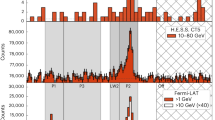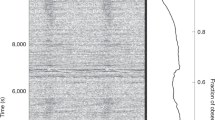Abstract
RECENT observations indicate that a typical globular cluster may contain hundreds of millisecond pulsars1,2. Because millisecond pulsars have some similarities to the Vela pulsar, which is known to be a source of γ-rays, they could also be gamma emitters of modest power. Here I estimate the γ-ray luminosity of globular clusters, assuming that they indeed harbour large numbers of millisecond pulsars. An upper limit obtained by the Cos-B satellite on the γ-ray emission from 47 Tucanae, which contains at least 10 millisecond pulsars1, is too large to constrain the model presented here, but the estimated luminosities are high enough to be detectable by the recently launched Gamma Ray Observatory. In the near future, γ-ray observations will thus be able to test this model, and the theory of γ-ray emission by millisecond pulsars.
This is a preview of subscription content, access via your institution
Access options
Subscribe to this journal
Receive 51 print issues and online access
$199.00 per year
only $3.90 per issue
Buy this article
- Purchase on Springer Link
- Instant access to full article PDF
Prices may be subject to local taxes which are calculated during checkout
Similar content being viewed by others
References
Manchester, R. N. et al. Nature 352, 219–221 (1991).
Kulkarni, S. R. Bull. Am. astr. Soc. 22, 1308 (1990).
Halpern, J. P. & Tytler, D. Astrophys. J. 330, 201–217 (1988).
Halpern, J. P., Grindlay, J. & Tytler, D. Astrophys. J. 296, 190–196 (1985).
Ruderman, M. & Cheng, K. S. Astrophys. J. 335, 306–318 (1988).
Ruderman, M., Shaham, J. & Tavani, M. Astrophys. J. 336, 507–518 (1989).
Ruderman, M., Shaham, J., Tavani, M. & Eichler, D. Astrophys. J. 343, 292–312 (1989).
Kluźniak, W., Ruderman, M., Shaham, J. & Tavani, M. Nature 339, 742–743 (1988).
Bhattacharya, D. & Srinivasan, G. J. Astr. Astrophys. 12, 17–25 (1991).
Grindlay, J. E., Covault, C. E. & Manandhar, R. P. Bull Am. astr. Soc. 22, 1286 (1990).
Cheng, K. S., Ho, C. & Ruderman, M. Astrophys. J. 300, 500–521 (1986); Astrophys. J. 300, 522–539 (1986).
White, N. & Stella, L. Mon. Not. R. astr. Soc. 321, 325–331 (1988); Nature 332, 416–417 (1988).
Harding, A. K., Tademaru, E. & Esposito, L. Astrophys. J. 225, 226–237 (1978).
Harding, A. K. Astrophys. J. 247, 639–649 (1981).
Bignami, G. F. & Hermsen, W. Ann. Rev. astr. Astrophys. 21, 67–108 (1983).
Author information
Authors and Affiliations
Rights and permissions
About this article
Cite this article
Chen, K. Gamma-ray emission from millisecond pulsars in globular clusters. Nature 352, 695–697 (1991). https://doi.org/10.1038/352695a0
Received:
Accepted:
Issue Date:
DOI: https://doi.org/10.1038/352695a0
This article is cited by
-
Millisecond pulsars from accretion-induced collapse as the origin of the Galactic Centre gamma-ray excess signal
Nature Astronomy (2022)
-
Globular clusters as gamma ray sources
Journal of Astrophysics and Astronomy (1992)
Comments
By submitting a comment you agree to abide by our Terms and Community Guidelines. If you find something abusive or that does not comply with our terms or guidelines please flag it as inappropriate.



